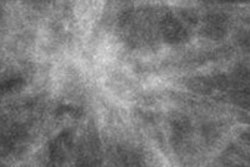
Automatic exposure control systems must be reconfigured when computed radiography (CR) is introduced, and regular quality assurance checks coupled with three yearly patient dose surveys allow optimum performance to be maintained, Scottish researchers have found.
"Chest imaging presents a particular challenge for all systems, because of the broad attenuation differences between the lungs and the mediastinum. Moreover, visualization of the texture within the lung parenchyma is particularly demanding. Therefore, different exposure conditions are often appropriate," noted Gurpreet Singh, PhD, senior practitioner clinical physicist at Gartnavel Royal Hospital in Glasgow, U.K. "Digital radiography provides greater potential for tailoring the exposure levels to the imaging requirements, which was not possible with SFS [screen film systems] radiography."
Singh and his colleagues have evaluated the introduction of CR systems across 20 hospitals in the west of Scotland, and have compared the patient dose levels attained in surveys undertaken in 2007 and 2010. After eight years of use, they have presented their experiences in an article published on 28 August in Radiation Protection Dosimetry.
The authors assessed the effects of raising tube potentials on image quality in terms of details and on contrast-to-noise ratio (CNR).
 These two chest phantom images at 75kV, 4.4 mAs (left) and 90 kV, 4.4 mAs (right) were evaluated in the Scottish study. Images courtesy of Gurpreet Singh, PhD.
These two chest phantom images at 75kV, 4.4 mAs (left) and 90 kV, 4.4 mAs (right) were evaluated in the Scottish study. Images courtesy of Gurpreet Singh, PhD."The spectral quality of the x-ray beam affects the imaging performance of CR detectors, particularly the contrast of details," they explained. "The contrast-to-noise ratio, which is the ratio of the signal and noise relating to larger structures, is useful for judging the visibility of features. Hence, the CNR gives useful information about the relative performance of radiographic imaging systems for different x-ray beam qualities. The CNR has been used to provide information on the relationship between image quality and tube potential."
The group found that dose levels for CR imaging similar to those used for 400 speed index SFS provide levels of image quality acceptable for diagnosis. Setting of automatic exposure control levels enabled dose-area product values to be maintained at 160 cGy cm2 for lumbar spine anteroposterior (AP), 250 cGy cm2 for lumbar spine lateral, 210 cGy cm2 for pelvis AP, and 260 cGy cm2 for abdomen AP.
Overall, their results showed that CNR details seen in test images at tube potentials of 85-90 kV did not differ significantly from those with lower potentials and gave lower entrance surface doses.
The CNRs decrease slightly with tube potential for similar image receptor doses, but, on the other hand, use of higher tube potential x-rays, which are more penetrating together with lower milliamphere second values, will reduce patient dose as more radiation reaches the image receptor, according to the authors. Finding the appropriate level of image quality is the most important objective in setting exposure factors for CR systems, and keeping the dose low should always be secondary, they stated.
The use of diagnostic reference levels help to verify that radiology departments are using acceptable dose levels, and enable hospitals that have higher doses to be identified, so that corrective action can be taken where required, they wrote. Recommendations should be made for hospitals where doses were found to be higher than the diagnostic reference level, such as changing the kilovolt and reducing the milliamphere second. Evaluation of patient doses every thre years or whenever equipment is replaced, helps to check that the dose levels are within acceptable limits and to ensure optimal performance, the researchers concluded.



















